
When talking about IPv6 development in China, people may have different impressions and responses. On the one hand, some people have the impression that China is quite ahead in IPv6 development. For many years (more than 15 years) the Chinese government has viewed IPv6 as an important part of its national strategy to drive the next generation of the Internet with funding invested and policies made. ISPs and content providers invested a lot to upgrade their IPv6 networks and set up IPv6 application pilots. Researchers and engineers from Chinese universities and vendors are very active in IETF IPv6-related working groups.
On the other hand, most of us nowadays, as commercial end users, are not aware of IPv6 in our daily use of the Internet in China. The customer premise network providers (Tier 2 & 3) do not offer IPv6. According to APNIC’s IPv6 monitoring statistics, the IPv6 adoption rate has remained below 2% in China for the past five years, which was in a sharp contrast to the IPv6 boom both across the globe and the APNIC region. Why?
On many occasions, questions on IPv6 adoption such as ‘why’, ‘how’ and ‘when’ are often raised, but no consensus has been reached in China. ISPs say that there is no demand from customers because there is no IPv6 content and applications. Content providers argue that if there is no IPv6 network or no traffic at all from customers, why should they provide IPv6 services? We are stuck here in a ‘chicken and egg’ problem: which one should come first?
My observation: the lack of IPv6 content is due to the fact that not so many Chinese use English websites and applications, and some of the top 10 IPv6-enabled websites, such as Google, Facebook, and YouTube, cannot be reached in mainland China. However, I still believe the ‘chicken and egg problem’ between IPv6 networks and content is temporary. It’s real but not the key reason.
So I return to the question, why?
To answer that question, it is vital to understand the status quo of IPv6 adoption in China. The APNIC Labs IPv6 monitoring project offers a view, as mentioned above, that shows the IPv6 adoption ratio stably below 2% for the past five years.
Fig 1: IPv6 Capacity in China from APNIC Labs IPv6 monitoring
With the help of my colleagues from QQ.com, the diagram below shows IPv6 traffic ratio in terms of PV (page view) and Bandwidth observed by QQ.com inside China. Similar to APNIC statistics, the ratio fluctuates across a span of one year. Unfortunately it turns out that it has decreased during 2016. The peak reached around 1.8% in bandwidth and 1.5% in PV at the beginning of 2016 — higher than the statistics of APNIC. It proves that many IPv6 users are active only in the domestic network of China.
Fig 2: IPv6 Traffic Ratio Statistics Collected by QQ.com
It’s worth sharing a little bit about how QQ.com/Tencent is progressing with IPv6.
QQ.com is China’s largest and most-used Internet portal, and is owned by Tencent, Inc. Alexa ranks QQ.com as the eighth-highest traffic website in the world. Tencent began the planning and development of IPv6 in its web-based services in 2012.
Different from counterparts with a more conservative approach, Tencent aims at the real use of IPv6 in its production network and services. Now, five years later, over 50% of its web-based services are upgraded to dual-stack including QQ.com, Tencent Weibo, Qzone and its open Dev platform. The daily peak IPv6 traffic volume reaches 300Mbps, a small number compared with Tencent’s entire traffic, but it is notable progress and a milestone in IPv6 commercial development in China.
Tencent’s progress in IPv6 reflects its long-term vision on its brand building as well as its globalization strategy. The emphasis on networking infrastructure helps Tencent build a competitive edge over its rivals.
IPv6 development in broadband networks
In China’s IPv6 development process, CERNET2 played a pioneer role with great contributions and efforts. CERNET2 is the first and largest IPv6 network testbed in China serving education and research. It is featured with an IPv6-only core, deployment of IPv6 transition protocols like IVI and 4over6, and large-scale implementation of source address validation improvements (SAVI). Now CERNET2 connects more than 600 campuses, covering six million users, and it aims to connect a further 1,200 campuses this year. Most global visible IPv6 users, websites, and applications in China are based on the network of CERNET2.
Fig 3: CERNET2 Network and Daily Traffic between Campuses
It is intuitive to think of copying the success and experiences from CERNET2 to commercial ISPs in China. However, the IPv6 upgrade for commercial networks is far more complicated than a campus network. As far as I know, for many years China Telecom took a leading role as a commercial ISP to promote and develop commercial IPv6 in China. The problems and situations it encountered are typical for all ISPs.
In 2009, a special, dedicated office was set up to promote IPv6 evolution inside China Telecom. In the early phase, the main effort was put in designing the road map, exploring technical approaches for the IPv6 transition, and testing, in cooperation with Tsinghua University, Beijing Internet Institute and vendors such as Huawei and ZTE.
After testing and validation in IPv6 pilot projects, China Telecom started to upgrade its two backbones, ChinaNet (163) and CN2. Now all links connecting the provinces are IPv6 capable. Over 220 MANs (metropolitan area network) are dual-stacked. More than 95% of total BRAS/MSE support IPv6. From a recent presentation I attended in China, it was reported that the number of users covered by an IPv6-capable network in China Telecom reaches 90 million.
Fig 4: China Telecom IPv6 Network
Does it sound all good? No. The difficulty right now lies in the “last mile” to end users, according to the people from the telcos. For many years, each telco in China had strict procurement requirements for networking devices to support IPv6 (a certificate-like “IPv6 ready” logo is served in this regard). But the CPE devices such as home gateways, home routers, WiFi Access Points, and other smart objects in users’ houses, purchased by end users, are not IPv6 enabled.
It is very hard to push vendors or educated customers to require IPv6 capability in the devices, because the demand of the market is still in its infancy. Some global vendors do not offer their IPv6-capable CPE products to customers when they believe customers are not asking for IPv6. So it becomes a bottle-neck for IPv6 penetration in fixed broadband networks.
IPv6 support in 4G LTE
Globally, IPv6 traffic from mobile networks in the past year has soared and has become the major impetus to global IPv6 traffic increases, such as the case of India and its mobile telco Reliance Jio.
What about the mobile networks in China? According to public reports and presentations, China’s major mobile service providers (like China Telecom and China Mobile) view LTE 4G as an opportunity to promote IPv6 from the start. They took early initiatives to pre-plan and build their LTE/VoLTE networks with IPv6 capacity. The good aspect is that in mobile networks, IPv6 capability can be integrated into the LTE EPC system in an end-to-end manner. And iPhones and Android phones support dual-stack too. The issue of “last mile” in fixed broadband networks does not exist in the mobile networks.
According to a local report, by the end of 2016, China Telecom has gained more than 10 million active IPv6 mobile users. That number in China Mobile is 70 million. All its VoLTE users can use voice by default via IPv6.
(One note: A colleague from China Mobile told me that Apple’s iPhone sold in China lacks IPv6 functionality for data PDP connections — only voice PDP connections can use the IPv6 network. If that is the case, one reasonable guess why is that the version of iPhone iOS released in China is designed on purpose to avoid poor performance due to IPv4 fallback issues).
To test whether IPv6 is available for end LTE users, I asked a small group of people to help me in a test. They have 4G LTE phones and live in different cities: Beijing, Shanghai, Shenzhen, Nanjing, and Changsha. The test simply looked for answers to:
- Does your phone receive an IPv6 address from your mobile services provider?
- Can you open an IPv6 website inside and outside of China?
To answer question 1, people only needed to open their phones to look at the information status page of the phone (although iPhones appear to conceal this information). An example is the page shown in my phone in the picture below, where I was sitting in the office in Yi Zhuang district, Beijing and using 4G LTE of China Mobile.
Fig 5: IP address information of LTE phone
To answer question 2, people needed to visit two websites using their phones:
2.1: ipv6.sjtu.edu.cn, an IPv6 website located inside one CERNET2 campus, Shanghai Jiao Tong University. If you can open it and find an IPv6 address shown in the top of this page, congratulations! You are connected inside China’s IPv6 Internet.
2.2: ipv6-test.com, a website outside China, is used to test IPv4 and IPv6 connections. If you can open it and an IPv6 address is visible in the second part of the test, congratulations! You are connected to the global IPv6 Internet.
The results in my phone (following images) show that I’m connected inside China’s IPv6 Internet but cannot access the IPv6 Internet outside China.
Fig 6: LTE phone visit IPv6.sjtu.edu.cn
Fig 7: LTE phone visit ipv6-test.com
I received 25 samples for this test. Twenty samples stopped at test 1. One passed the first test, but stopped at 2.1. Two users from Beijing Mobile, one Nanjing Telecom user and one user of Changsha Telecom reported that they passed the first test and 2.1. None successfully passed 2.2.
After communications between colleagues from China Telecom and China Mobile, it turns out that currently the commercial IPv6 network is not fully open to the global Internet. In some cases, they are IPv6 islands. So in this case, the issue of “last mile” is reaching outside China.
Besides the “last mile” problems, China’s IPv6 network is not fully connected between ISPs where islands exist and the network is fragmented. I drew a diagram trying to illustrate the IPv6 network situation in China as mentioned above.
Fig 8: An illustration of China’s IPv6 Network Situation
Some speed bumps on the road to a fully connected IPv6 network
As a witness to China’s IPv6 development, I have reason to say that the investment and efforts put into IPv6 in China are not small, but huge. The IPv6 guys in China are not going through the motions; they are working very hard. Actually, they are the most talented and determined group of people in the world, as far as I can tell. However, it is true that there are still some speed bumps on the road to achieving a fully connected IPv6 network that we need to consider and address.
Due to the lack of IPv6 infrastructure, the Internet based on IPv4 networks does not stop to wait. Workarounds on IPv4 depletion are still proceeding. Technologies like NAT/CGN are still widely deployed. NAT-friendly technologies are developed as well, like PCP, virtualization and server sharing, Happy Eyeballs, SPDY with CGN. The use of private IPv4 addresses has become a serious trap, dragging the process towards a fully connected IPv6 network. In addition, the global IPv4 trading market has become prosperous. In my view it leads to routing fragmentation as well as less urgency towards IPv6 development for countries and companies.
Two years ago I gave a presentation describing a competition between IPv4 and IPv6, not only in terms of penetration and connectivity, but their performance as well. Now this scenario is happening, when services providers have to decide whether to switch or upgrade their services to support IPv6 (the apparent special version of Apple’s iPhone iOS released in China is an example). To enable the network to support IPv6 is one thing; to maintain an IPv6 network as good as the existing IPv4 network is another.
Some poor IPv6 operational performances in initial deployments, in terms of latency and packet loss rate, have made some people reluctant to try IPv6 again. For instance, in China, the users’ experience over the connections between different ISPs is poor. Network optimization and traffic scheduling using DNS, CDN and cloud technologies is very commonplace and advanced in IPv4 networks, but not necessarily in IPv6. In addition, some IPv6-only projects like the Yeti DNS Project have shown some issues on IPv6 fragmentation and network instability.
There is no small gap between IPv4 and IPv6 in real daily operation. If we remain watching and waiting without any action, the gap will become too large to close, it will become a chasm. While public measurement of IPv6 usage is already available, it would be valuable to see more public measurement of IPv6 performance compared with IPv4.
Another speed bump is that people still lack determination and confidence in IPv6. I see three distractions here.
Firstly, some conservative ideas still exist that view IPv6 as insecure or a threat to current network operations and regulations. The Internet Society summarized a series of IPv6 security myths that cover the common misunderstandings and concerns on IPv6 security. I think more IPv6 education, information sharing and advocacy is needed, as well as more IPv6 success stories and best practices.
Secondly, IPv6 has, for a long time, been portrayed and positioned as a network innovation and key technology for the next-generation of the Internet. This position stirred people’s enthusiasm to explore the space of the problem and devise solutions for an IPv6 transition. It’s good for academic discussion and research. However, when a dozen IPv6 transition tools emerged, people naturally got the feeling that the IPv6 transition is too complex and hesitated to implement without a clear roadmap. From my perspective, it caused concerns for some of China’s ISPs and vendors to deploy IPv6 five years ago, and now the consensus is that emphasis should be put on dual-stack deployment.
Thirdly, some people may have an impression that IPv6 is for future use, not for now. As a result, when new network technology buzzwords emerged, such as Software Defined Networks, Network Function Virtualization, and Non-IP solutions like Name Data/Content Centric Networking, people are likely to hesitate and wonder if there will be another disruptive innovation and technology replacing the current Internet based on TCP/IP.
Conclusion and outlook
Despite the speed bumps, I am pretty optimistic about IPv6 development in the near future. The good news is that the global IPv6 usage continues to rise (Google’s measure is currently 18%), which brings encouragement as well as pressures on both industry and government.
Recent IPv6 stories and best practice from India and Vietnam have stimulated the determination of many people in IPv6 circles in China. In addition, the Internet in China is sill booming. The Internet of Things is a favourable factor for IPv6 development in the near future in China.
From the beginning of 2017, I have seen more and more IPv6 initiatives run by people from the private sector in China. IPv6 offerings from technology providers are maturing and the market requirement for IPv6 is rising.
CERNEWTECH, the subsidiary of CERNET, began to bring its IPv6 know-how to the commercial networking market two years ago. Now it is working with major customer network providers such as Founder Broadband Network and Dr. Peng Telecom Media Group to help crack the “last mile” problem to their customers with customized IPv6 CPE solutions. Another example is cloud provider AWS, which has built IPv6 BGP peer with CNGI-6IX. Apple and Microsoft/Azure are likely to follow later this year.
The consensus around IPv6 and determination is building gradually. It is said that Chinese ISPs will fully open their IPv6 networks to the global IPv6 Internet this year. If so, 2017 will be a historic and memorable year for Chinese IPv6 development.
“We must complete the transition to a fully connected IPv6 network as soon as possible. This does not mean we have to abandon the use of IPv4, only that we need connectivity as complete with IPv6 as we have had with IPv4 — and we need it now.” — Vint Cerf
Acknowledgement
I would like to thank colleagues in China’s IPv6 community who shared information to help complete this article. Special thanks to people who reviewed and gave me editing suggestions: Professor Ma Yan from BUTP, Dr Xie Chongfeng from China Telecom, and Huang Lu from China Mobile.
Linjian (Davey) Song is the senior DNS architect in Alibaba Cloud. He has more than 15 years’ research background on Internet architecture, especially in IPv6 , DNS, Internet security and privacy. He was previously Lab Director at Beijing Internet Institute (BII).
The views expressed by the authors of this blog are their own and do not necessarily reflect the views of APNIC. Please note a Code of Conduct applies to this blog.



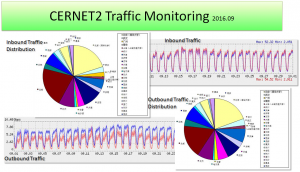
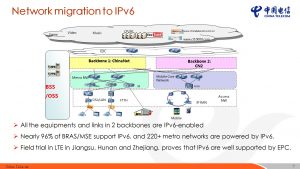
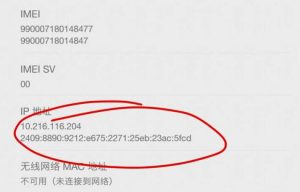

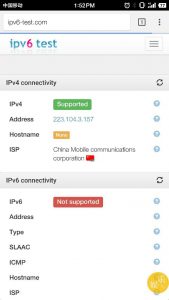
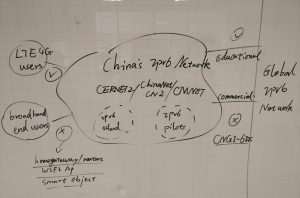
The outcome of my conversations with ISPs is completely different. Maybe that’s because you are a member of APNIC, and I am just a customer looking for a server colocation with IPv6.
What they say is that they did provide IPv6 in the past, and were forced to remove it and create some fake nodes to inflate adoption statistics. They were forced to remove it because they are legally required to enforce the censorship (aka the Great China Firewall), and the firewall software does not cope well with IPv6 – badly enough so that they failed the government audit.